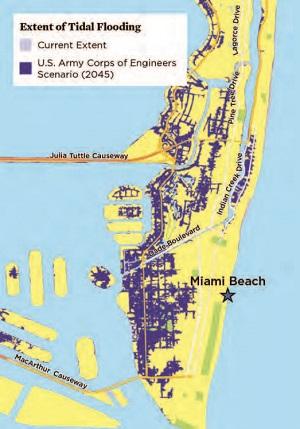Civil engineers in the United States have observed the current problem Miami has with floods. A new study by Miami-Dade County projected that due to the rising of sea levels, there will be a flood every day by 2045. Currently, Miami experiences 45 floods a year according to Fusion.net, this number would rise to 80. The Union of Concerned Scientists (USC) perused data that the Army Corps of Engineers compiled and as a result are issuing the latest warning for something to be done.
The USC have since released a report in which they say:
By 2045, sea level in Miami-Dade County is expected to rise about 15 inches above current levels, according to a projection by the US Army Corps of Engineers. With this increase, in just 30 years' time, flood-prone locations in Miami-Dade County's coastal communities would face roughly 380 high-tide flood events per year, and the extent of tidal floods would expand to affect new low-lying locations...
A one-foot increase in sea level is estimated to threated up to $6.4 billion in taxable real estate in the country overall
 Credit: USC
Credit: USC
Now, what civil engineers are doing in the Miami-Dade County area could redefine what other coastal towns or villages do in the event that sea levels rise to the extent that they are in Miami.
The country has currently pumped $20 billion into storm protection efforts after Hurricane Sandy in 2012. The Army Corp Engineers were also tasked with surveying the areas in trouble of immediate flooding. They concluded that 6 million people are in vulnerable areas. The estimated damage that could be caused by 2045 is $616 trillion [Miami Herald]. It sounds like a civil engineering headache.
The University of Miami has also conducted research into the area and published their findings in a study titled: Increasing flooding hazard in coastal communities due to rising sea level: Case study of Miami Beach, Florida .
In the highlights section of the study, the researchers say:
Increasing sea level in the Miami area correlates with weakening of the entire Gulf Stream system.
Engineering solutions to SLR should rely on regional sea level rise rate projections and not only on the commonly used global SLR projections
The researchers are warning that Miami is an isolated case on its own and cannot be aligned with what is happening globally. What does, however, make the situation worse is the global climate change that adds inches to the sea level. The problem with Florida, according to the engineers researching at the University of Miami, is that they are most vulnerable due to the state's " low elevation, large population concentrations and economic importance."
Thus, engineers are installing new storm sewers and pumps, according to NPR. Miami Beach will also reportedly see a $400 million project that will include building 80 pump stations throughout the city. The more dire the situation becomes, the more civil engineers the state will look to employ to reverse the damage of oncoming tidal rises.
Here is a video with physical proof of what civil engineers have been doing since the end of 2014 in Miami. The government claims they will try and keep the Miami area dry for up to 500 years. Although, renewed case studies show that that is a tall order.
